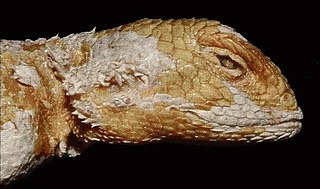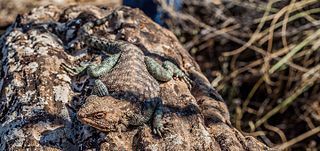
Agama is a genus of small-to-moderate-sized, long-tailed, insectivorous Old World lizards. The genus Agama includes at least 37 species in Africa, especially sub-Saharan Africa, where most regions are home to at least one species. Eurasian agamids are largely assigned to genus Laudakia. The various species differ in size, ranging from about 12 to 30 centimetres in length, when fully grown.

Holaspis is a genus of equatorial African lizards in the family Lacertidae. These lizards are capable of gliding flight for distances of 30 meters.

Hardwicke's bloodsucker is an agamid lizard and found in South Asia.

Blanford's rock agama is species of lizard in the family Agamidae. The species is endemic to Peninsular India. One of two species in the genus, P. blanfordanus is found mainly to the east of the distribution of P. dorsalis. Unlike the other species, the male P. blanfordanus in breeding season has the red body color restricted to the head and lacks the broad dorsal stripe.

The shield-tailed agama, also known commonly as the dwarf shield-tailed agama, Taylor's strange agama, and the turnip-tailed agama, is a species of lizard in the family Agamidae. The species is endemic to the Horn of Africa.

Ameiva ameiva, also known as the giant ameiva, green ameiva, South American ground lizard, or Amazon racerunner, is a species of lizard in the family Teiidae found in Central and South America, and some Caribbean Islands.

The East African armadillo lizard, dwarf sungazer, or tropical girdled lizard is a species of arboreal or rupicolous (rock-dwelling) lizard endemic to East Africa.
The Ukinga girdled lizard is a poorly known species of girdled lizard from central Tanzania. They are rupicolous (rock-dwelling) and feed on small arthropods.

The common agama, red-headed rock agama or rainbow agama is a species of lizard from the family Agamidae found in most of sub-Saharan Africa. To clear up centuries of historical confusion based on Linnaeus and other authors, Wagner et al. designated a neotype for the species, using a previously described specimen from Cameroon in the collection of the Zoologisches Forschungsmuseum Alexander Koenig in Bonn. The species name was formerly applied to a paraphyletic collection of taxa ; subsequent mitochondrial DNA analysis of various populations indicates they represent separate species. Consequently, three former subspecies A. a. africana, A. a. boensis, and A. a. mucosoensis are now considered separate species, and A. a. savattieri is considered synonymous with A. africana.
The Elmenteita agama or Elmenteita rock agama is a species of lizard from the family Agamidae. The species is endemic to Kenya with the type locality being Lake Elmenteita, hence the common name.

The tropical spiny agama, northern ground agama, or Peter's ground agama is a species of lizard from the family Agamidae, found in most of sub-Saharan Africa. The species is found in South Africa, Mozambique, Namibia, Botswana, Zambia, Eswatini, southern Democratic Republic of the Congo (Zaire), southwestern Kenya, and central Tanzania.

Agama rueppelli, commonly known as the arboreal agama or Rüppell's agama, is a species of lizard in the family Agamidae. The species is endemic to East Africa.

The southern rock agama or southern African rock agama is a species of lizard from the family Agamidae that occurs in Southern Africa in Zambia, South Africa, Eswatini, Mozambique, Zimbabwe and Botswana. It lives in small colonies on rocky outcrops, and the males are very conspicuous for their bright blue heads.

Phrynocephalus persicus, commonly known as the Persian toad-headed agama, is a small diurnal desert lizard of the family Agamidae. It is the westernmost representative of the Central Asian genus of toad-headed agamas Phrynocephalus and is only known from deserts and semideserts of Iran and possibly Azerbaijan.

The red tegu is a lizard native to western Argentina, Bolivia and Paraguay. It is sold in the pet trade around the world due to its ease of care and relatively docile nature.
Cope's arboreal alligator lizard is a species of lizard found in two isolated locations in Guatemala, one in the Alta Verapaz Department and one in the Jalapa Department. These lizard are found only in high altitudes of 2,000 to 2,600 feet above sea level, on the west and south sides of the mountain ranges. This lizard is one of 28 species of alligator lizards, most being arboreal, meaning they live in trees. These omnivores are considered endangered because of their small population size and they face extinction due to habitat degradation and from pressures of the pet trade.
Agama robecchii, commonly known as Robecchii's agama, is a species of lizard in the family Agamidae. The species is endemic to the Horn of Africa.

Agama bibronii, Bibron's agama or the North African rock agama, is a species of lizard belonging to the family Agamidae from north western Africa.
Cordylus beraduccii, also known commonly as the Maasai girdled lizard, is a species of girdled lizard in the family Cordylidae. The species is native to East Africa.
Acanthocercus minutus, the blue-headed tree agama, black-necked agama, southern tree agama, or blue-throated agama, is a species of lizard in the family Agamidae. It is a small lizard found in Ethiopia and Kenya.

















